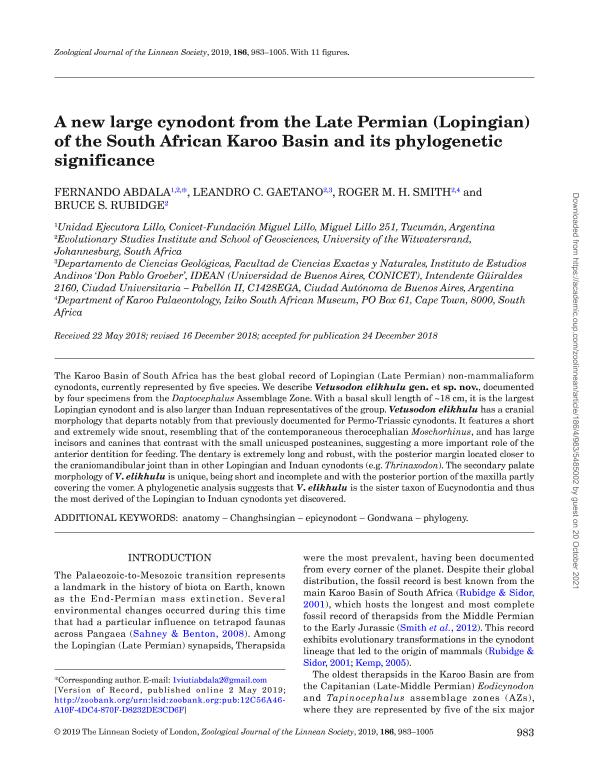Artículo
A new large cynodont from the Late Permian (Lopingian) of the South African Karoo Basin and its phylogenetic significance
Fecha de publicación:
08/2019
Editorial:
Wiley Blackwell Publishing, Inc
Revista:
Zoological Journal of the Linnean Society
ISSN:
0024-4082
Idioma:
Inglés
Tipo de recurso:
Artículo publicado
Clasificación temática:
Resumen
The Karoo Basin of South Africa has the best global record of Lopingian (Late Permian) non-mammaliaform cynodonts, currently represented by five species. We describe Vetusodon elikhulu gen. et sp. nov., documented by four specimens from the Daptocephalus Assemblage Zone. With a basal skull length of ~18 cm, it is the largest Lopingian cynodont and is also larger than Induan representatives of the group. Vetusodon elikhulu has a cranial morphology that departs notably from that previously documented for Permo-Triassic cynodonts. It features a short and extremely wide snout, resembling that of the contemporaneous therocephalian Moschorhinus, and has large incisors and canines that contrast with the small unicusped postcanines, suggesting a more important role of the anterior dentition for feeding. The dentary is extremely long and robust, with the posterior margin located closer to the craniomandibular joint than in other Lopingian and Induan cynodonts (e.g. Thrinaxodon). The secondary palate morphology of V. elikhulu is unique, being short and incomplete and with the posterior portion of the maxilla partly covering the vomer. A phylogenetic analysis suggests that V. elikhulu is the sister taxon of Eucynodontia and thus the most derived of the Lopingian to Induan cynodonts yet discovered.
Palabras clave:
ANATOMY
,
CHANGHSINGIAN
,
EPICYNODONT
,
GONDWANA
,
PHYLOGENY
Archivos asociados
Licencia
Identificadores
Colecciones
Articulos(UEL)
Articulos de UNIDAD EJECUTORA LILLO
Articulos de UNIDAD EJECUTORA LILLO
Citación
Abdala, Nestor Fernando; Gaetano, Leandro Carlos; Smith, Roger M. H.; Rubidge, Bruce; A new large cynodont from the Late Permian (Lopingian) of the South African Karoo Basin and its phylogenetic significance; Wiley Blackwell Publishing, Inc; Zoological Journal of the Linnean Society; 8-2019
Compartir
Altmétricas




